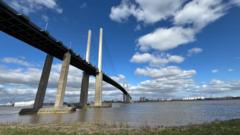Will Dartford Crossing Charges Rise for Drivers?

Understanding the Upcoming Changes to Dartford Crossing Charges
In a significant development for motorists and commuters, the standard charge for car drivers using the Dartford Crossing is set to rise from £2.50 to £3.50 starting in September. This announcement has sparked considerable debate among local MPs and residents, with various stakeholders expressing their views on the implications of these changes. In this article, we will explore the reasons behind the increase, its potential impact on traffic management, and what it means for local residents and drivers.
The Dartford Crossing: An Overview
The Dartford Crossing, which links Essex and Kent via the M25, serves as a vital transportation route for approximately 180,000 vehicles daily. This significant volume of traffic highlights the importance of the crossing in facilitating regional connectivity. Originally opened in 1991, the Queen Elizabeth II Bridge is a key infrastructure element that supports both local and national transport networks.
Reasons for the Charge Increase
Transport Minister Lilian Greenwood stated that the current charge of £2.50 is no longer sufficient to manage demand effectively. The increase to £3.50 aims to address the following key issues:
- Traffic Volume: With traffic levels exceeding the crossing's design capacity, delays have become a common experience for drivers.
- Infrastructure Maintenance: The funds collected from tolls contribute to the ongoing maintenance and operation of the crossing, ensuring safety and efficiency for all users.
- Discounts for Local Residents: Greenwood emphasized that significant discounts will be available for residents living near the crossing, mitigating the impact of the fee increase on local commuters.
Comparative Analysis of Toll Charges
The forthcoming charge increase is the first adjustment since 2014. Greenwood noted that, had the fees kept pace with inflation since then, the charges would have been much higher. Here’s a breakdown of the new charges:
- Standard Car Drivers: £3.50
- Pre-Pay Account Holders: £2.80
- Buses and Coaches: Up to £4.20
- Goods Vehicles (2 Axles): Up to £4.20
- Goods Vehicles (More than 2 Axles): Up to £8.40
This tiered approach allows for differentiated pricing based on vehicle type, which reflects the varying impacts different vehicles have on traffic flow and road wear.
Political Reactions to the Charge Increase
The announcement has elicited mixed reactions from local politicians. Jen Craft, the MP for Thurrock, expressed disappointment and plans to urge the Transport Minister to reconsider the increase. Craft herself is a regular user of the crossing and understands the implications of higher charges for her constituents.
In contrast, Conservative MP Richard Holden described the government’s decision as “underhanded,” labeling the charge increase as just another tax on motorists who have no alternative routes. He insists that the justification for the fee hike should be explained in Parliament, where it can be openly discussed and scrutinized.
Reform UK MP James McMurdock echoed similar sentiments, criticizing the government for failing to follow through on promises to remove the tolls once the construction costs were covered. He questions how increasing costs will contribute to economic growth.
Local Implications and Community Concerns
Jim Dickson, the Labour MP for Dartford, acknowledged the price rise as "unwelcome" but was pleased that local residents would continue to receive discounts on annual passes. He emphasized the need for fairness in how local users are treated, especially in light of potential future increases.
Residents and local drivers are understandably concerned about how the increased tolls will affect their daily commute, expenses, and overall traffic conditions at the crossing. The Dartford Crossing is often seen as a necessary route for those commuting between regions, and many feel there should be a more transparent discussion about the allocation of toll revenue.
Future Developments: The Lower Thames Crossing
In a related development, the Treasury recently announced a £590 million investment in the Lower Thames Crossing, a new tunnel designed to alleviate traffic congestion at the Dartford Crossing. National Highways anticipates that this new infrastructure will reduce traffic by approximately 20%, offering long-term relief for commuters and enhancing regional connectivity.
Conclusion: A Balancing Act
As the Dartford Crossing prepares for its charge increase, the government faces the challenging task of balancing infrastructure needs with public sentiment. While the increase may be necessary for effective traffic management and road maintenance, local residents' concerns about rising costs cannot be overlooked. The discussions surrounding this change highlight the ongoing need for dialogue between government officials, local representatives, and the communities they serve.
In light of these changes, it’s essential for commuters and stakeholders to stay informed about how the tolls will impact their travel plans and local economies. As the Dartford Crossing continues to evolve, so too does the necessity for effective solutions that cater to the needs of all users. Will the new toll structure and the anticipated Lower Thames Crossing provide the relief that drivers require? Only time will tell.
FAQs About the Dartford Crossing Charge Increase
What is the new charge for car drivers using the Dartford Crossing?
The new charge for car drivers will be £3.50 starting from September.
Will local residents receive any discounts on the new charges?
Yes, significant discounts will be available for local residents who use the crossing regularly.
When was the last time the charges were increased?
The charges were last increased in 2014.
What are the charges for other vehicle types?
- Buses and Coaches: Up to £4.20
- Goods Vehicles (2 Axles): Up to £4.20
- Goods Vehicles (More than 2 Axles): Up to £8.40
What is the Lower Thames Crossing?
The Lower Thames Crossing is a new tunnel under the estuary, linking Tilbury in Essex and Gravesend in Kent, expected to help reduce traffic at the Dartford Crossing by 20%.
As changes to the Dartford Crossing take effect, how do you think they will impact your daily travel? #DartfordCrossing #TrafficManagement #LocalEconomy
Published: 2025-06-17 20:07:12 | Category: technology



